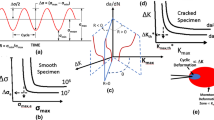Abstract
Halford's plastic-energy concept for lowcycle fatigue is extended to the medium- and high-cycle ranges. The resulting equations are compared with 74 sets of data in the medium- and high-cycle ranges. The difference in stress between theory and experimental data is less than ±5 percent.
The plastic-hysteresis-energy analysis for fatigue is shown to be consistent with the octahedral shear-stress theory. In addition, an improvement is presented for Manson's correlation for the total strain amplitude at 104 cycles.
Similar content being viewed by others
Abbreviations
- c :
-
Coffin-Manson constant (fatigue ductility exponent)
- N :
-
number of cycles to failure
- n′:
-
strain-hardening exponent
- W f :
-
fatigue toughness, in.-lb/in.3
- ΔW :
-
plastic hysteresis energy per cycle, in.-lb/in.3
- ΔW o :
-
endurance hysteresis energy per cycle, in.-lb/in.3
- ε f :
-
true fracture ductility
- ε p :
-
true plastic-strain amplitude
- ε T :
-
total-strain amplitude
- σ a :
-
true-stress amplitude, psi
- σ f :
-
true fracture stress, psi
- σ o :
-
endurance limit, psi
- σ μ :
-
ultimate tensile strength, psi
References
Inglis, N. P., “Hysteresis and Fatigue of Wohler Rotating Cantilever Specimen,” Metallurgist, 23–27 (February 1927).
Hanstock, R. F., “Damping Capacity, Strain Hardening and Fatigue,”Proc. Phys. Soc.,59,275–287 (1947).
Haigh, B. P., “Hysteresis in Relation to Cohesion and Fatigue,”Trans. Faraday Soc.,24,125 (1958).
Geberich, W. W., “The Phenomena of Cumulative Damage in Stress Cycling and Strain Cycling Fatigue,” Syracuse University Research Institute Department, No. Met. 575–594T3 (April 1959).
Feltner, C. E., andMorrow, Jo Dean, “Microplastics Strain Hysteresis Energy as a Criterion for Fatigue Fracture,”Trans. ASME, Series D, Jnl. Basic Eng.,18,15–22 (1961).
Halford, G. R., andMorrow, Jo Dean, “Low-Cycle Fatigue in Torsion,”Proc. ASTM,62,695–709 (1962).
Martin, D. E., andBrinn, J., “Some Observations on the Plastic Work Required to Fracture Stainless Steel Under Cyclic Loading,”Proc. ASTM,59,677–690 (1959).
Martin, D. E., “An Energy Criterion for Low-Cycle Fatigue,”Trans. ASME, Series D, Jnl. Basic Eng.,81,565–571 (1961).
Topper, T. H., andBiggs, W. D., “The Cyclic Behavior of Mild Steel at Low Endurances,”Appl. Mat. Res.,5,131–137 (1966).
Halford, G. R., “The Energy Required for Fatigue,”Jnl. Mat.,1 (1),3–18 (March1966).
Tavernelli, J. F., andCoffin, L. F., “Experimental Support for a Generalized Equation Predicting Low Cycle Fatigue,”Trans. ASME, Series D, Jnl. Basic Eng.,84,533–541 (1962).
Coffin, Jr., L. E., “Low Cycle Fatigue: A Review,”Appl. Mat. Res.,1 (3),129–141 (October1962).
Manson, S. S., “Behavior of Materials Under Conditions of Thermal Stress,” Heat Transfer Symposium, University of Michigan Engineering Research Institute, 9–75 (1953).
Manson, S. S., “Behavior of Materials Under Conditions of Thermal Stress,” National Advisory Committee of Aeronautics Technical Note 2933 (1954).
Manson, S. S., “Fatigue, A Complex Subject—Some Simple Approximations,”Experimental Mechanics,5 (7)193–226 (1965).
Smith, R. W., Hirschberg, M. H., and Manson, S. S., “Fatigue Behavior of Material Under Strain Cycling in Low and Intermediate Life Range,” National Advisory Committee of Aeronautics Technical Note D-1574 (1963).
Manson, S. S., Discussion of Ref. 11, Trans. ASME, Series D, Jnl. Basic Eng.,84,537,541 (1962).
Dalan, T. J., andYen, C. S., “Some Aspects of the Effect oof Metallurgical Structure on Fatigue Strength and Notch-Sensitivity of Steel,”Proc. ASTM,48,664–695 (1948).
Peterson, R. E., “Engineering and Design Aspects,”Mater. Res. Sid.,3 (2)122–139 (February1963).
Morrow, J., andJohnson, T. A., “Correlation Between Cyclic Strain Range and Low-Cycle Fatigue Life of Metals,”Mater. Res. Std.,5,30–32 (January1965).
Manson, S. S., and Hirschberg, M. H., “Fatigue Behavior in Strain Cycling in the Low- and Intermediate-Cycle Range,” Proceedings of the 10th Sagamore Army Material Research Conference, Raquette Lake, New York, 133–178 (1963).
Johansson, A., “Fatigue of Steels at Constant Strain Amplitude and Elevated Temperature,” Colloquium on Fatigue (IUTAM), Stockholm, 112–121 (1955).
Tavernelli, J. F., andCoffin, L. F., “A Compilation and Interpretation of Cyclic Strain Fatigue Test on Metals,”Trans. ASM, 51, 438 (1959).
Low, A. C., “Short Endurance Fatigue,” Proceedings of the International Conference on Fatigue of Metals, The Institution of Mechanical Engineers, London, 206–211 (1956).
Benham, P. P., andFord, H., “Low Endurance Fatigue of a Mild Steel and an Aluminum Alloy,”Jnl. Mech. Eng. Sci.,3,119–132 (1961).
Majors, M., Mills, B. D., andMacGregor, C. W., “Fatigue Under Combined Pulsating Stresses,”Jnl. Appl. Mech.,16,269–276 (1949).
Marin, J., “Strength of Steel Subjected to Biaxial Fatigue Stresses,” Weld. Jnl. Res. Suppl.,21,554–559.
Marin, J., “Interprelation of Fatigue Strengths for Combined Stresses,” Proceedings of the International conference on Fatigue of Metals, Institution of Mechanical Engineers, London, 184–194 (1956).
Findley, W. N., Coleman, J. J., and Hanley, B. C., “Theory for Combined Bending and Torsion Fatigue with Data for SAE 4340 Steel,” Proceedings of the International Conference on Fatigue of Metals, Institution of Mechanical Engineers, London, 150–157 (1956).
Marin, J., “Mechanical Behavior of Engineering Materials,”Prentice Hall Inc., Englewood Cliffs, New Jersey, 142–144 (1962).
Author information
Authors and Affiliations
Additional information
Consultant, IBM Corp.
Rights and permissions
About this article
Cite this article
Chang, C.S., Pimbley, W.T. & Conway, H.D. An analysis of metal fatigue based on hysteresis energy. Experimental Mechanics 8, 133–137 (1968). https://doi.org/10.1007/BF02326108
Issue Date:
DOI: https://doi.org/10.1007/BF02326108




